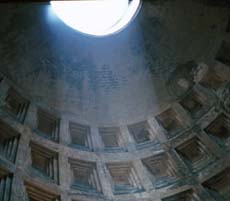index
Non-concentric places
click on images for full-size:




Oculus at the Pantheon, Rome

At Lunenburg, Nova Scotia

Connections in the air, New Mexico
Places featuring a center, or nested sets of places relating to a hierarchical center, give us a reassuring sense of being settled and located convincingly. Concentric identities can be graphed onto tree structures, where each smaller branch connects neatly to only one larger branch and is easily located. In such structures legitimacy flows along the tree. Depending on your political or epistemological theory, legitimacy flows from the universal to the particular, or vice versa, but in either case it flows along the neatly ordered branches of the tree.Lists and links break trees. Hierarchical tree-structures are replaced by network structures, multiply connected, where nodes are accessible from one another by many routes, without going through one fixed set of higher-level nodes. There may be nodes self-declared to be principal summaries or groupings, but they can be routed around, since they have no structural dominance. Links can bypass them, or create rival overviews.Beneath and around the trees, there has always been discontinuity, cases that didn't quite fit, and multiple connections that broke the neat structure. Now places and identities have become aggressively connected in non-concentric and non-hierarchical ways. Those hierarchical structures that remain have become shallower, and have lost most of their substantive power to define identities. We are not restricted to older topologies of connection. On the other hand, there is no need to shun or flee hierarchical and concentrical places. We do not have to live in nomadic tents to be free from hierarchy and centers, as long as those are open to a context of possibilities that they do not dominate. That proviso is important, because so many hierarchical and concentric places embody substantial oppressions, and try to close off connections to wider possibilities.
New kinds of unities in newer places can help free us, but they also can be used in the service of domination. Even a spacious openness to wider possibilities, though generally liberating, could lead to a "surfing" mode of being in places that avoids confronting the details and oppressions of any particular place.